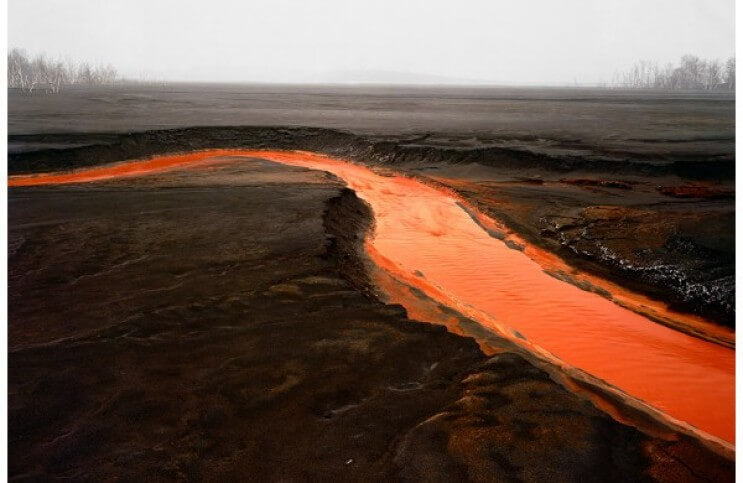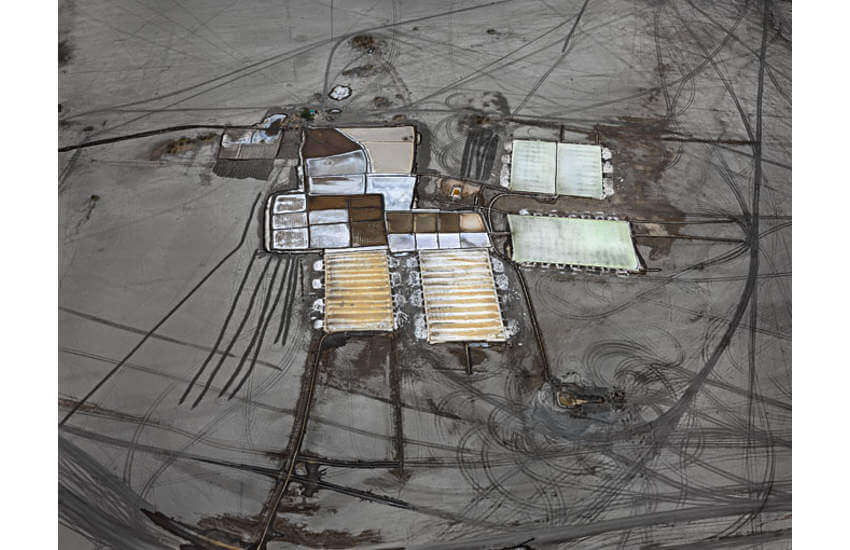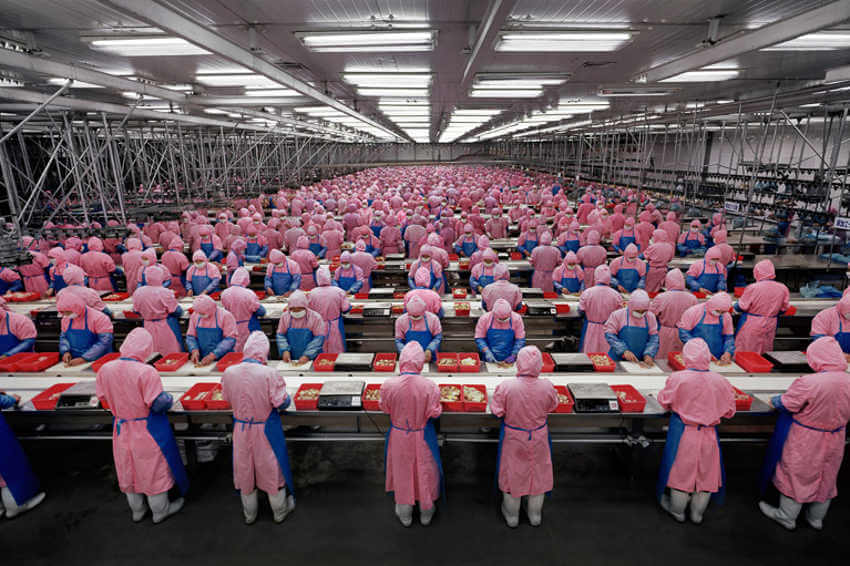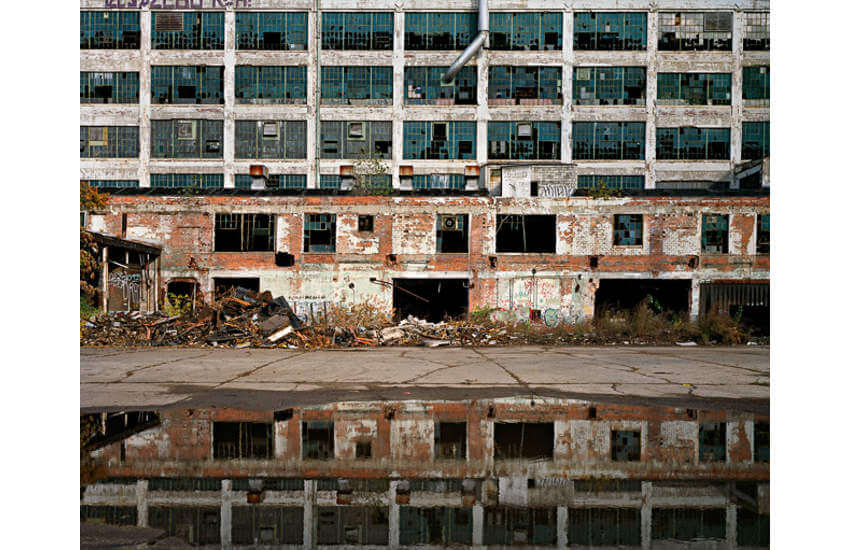
Edward Burtynsky and Landscapes Like No Other
Canadian photographer Edward Burtynsky has been photographing the natural world for nearly four decades. He began his career in the late 1970s, photographing natural landscapes from a strictly formalist perspective, framing them in such a way that the compositions mimicked Abstract Expressionist paintings. As a passage on his website explains, “Foremost in his mind was the Abstract Expressionist treatment of pictorial space as a dense, compressed field evenly spread across the entire surface of a large composition.” But over the course of the next few years, Burtynsky expanded the modest goals he had initially set for his photographic career. Rather than simply attempting to create interesting, Modernists compositions, he began searching for subject matter that could allow him to simultaneously make social, political, economic and cultural statements with his work. In a series titled Railcuts he captured images that portray the physical trauma caused to the land by the construction of trans-national railroad tracks. In a series called Homesteads he documented the precarious ways humans transform their natural surroundings when constructing homes, neighborhoods and towns. For his series called Tailings he photographed the apocalyptic-looking wastelands that tend to be left behind by the rivers of waste products that ooze from the earth as minerals are extracted and separated from their ore during mining operations. These and the many other series he has produced have earned Burtynsky a TED Prize, led to two award-winning documentaries about his work, and placed Burtynsky firmly on the front line of the environmentalist movement. He is experiencing great success as a photographer, but I am left with a question in terms of the true value of his photographs: are they activism, are they journalism, or are they art?
The Abstract Photography Conundrum
Photographers are intermediaries between spectacles and spectators. Be their subject a car accident, a riot, a war, a wild animal, a solar eclipse, a fashion model, a natural or unnatural landscape, or a colorful geometric composition created in a studio or on a computer, it is all the same: they require something visible to capture—ideally something fascinating—that will in turn capture and hold the interest of the viewer. But since the earliest days of fine art photography, when artists like Alvin Langdon Coburn and Man Ray were first investigating, among other things, what a phrase like abstract photography might mean, photographic artists have been forced to grapple with the essential nature of photography: thatit is a medium designed to capture reality.
A photograph is an imprint—a captured moment—created when light interactsin a controlled way with some concrete, objective, observable phenomenon. How then could a photograph ever possibly be abstract? Did not whatever shows up in a photographic image truly exist, at least for a fraction of a second, exactly as it is being depicted? It must have, or it would not be there. So yes, there is an argument to be made—and many have tried to make it—that every photograph is by definition objective. Thus it is complicated for photographers to toil in the middle ground between abstraction and realism. When they photograph reality they invite judgements about the subject matter that distract the viewer from appreciating the formal qualities of the image, such as its use of color, shape and line. But when they become too far removed from the photographic process, say by eliminating the camera from the process, fundamental questions are raised about whether the end product is even a photograph. After all, just using paint to make a thing does not in itself make that thing you made a painting.
 Edward Burtynsky - Salt Pan #16, Little Rann of Kutch, Gujarat, India, 2016
Edward Burtynsky - Salt Pan #16, Little Rann of Kutch, Gujarat, India, 2016
Spectacles Help Us See
Edward Burtynsky avoids that conundrum by embracing the notion that spectators are always naturally going to develop personal emotional reactions to whatever photographic image they happen to look at, and running with it. He has remained interested in formalism, as is demonstrated by the abstract patterns, textures and compositions that he captures when framing the natural and manufactured landscapes that he photographs. Anyone familiar with 20th Century abstract art history can probably make associations between his photographs and the work of various Modernist painters. But rather than focusing solely on that point—which could seem a bit trite—Burtynsky combines his love for Modernist imagery with a passion for documenting something of pressing concern to his generation: the large-scale, industrial repurposing of the natural world.
Behold the array of bright pink shapes in his 2005 photograph Manufacturing #17, of a chicken processing plant in China. The striking color is what is immediately apparent to me. A sea of pink with bits of red, white and blue, framed beneath a horizon of grey and white. Color, pattern and shape could easily be all this photograph is about. I blur my eyes and, aside from the precision of the forms and the geometric qualities of the composition, I could be looking at a Philip Guston painting. But then I look more closely. Each of those pink shapes is a human being whose job it is to stand all day in a massive, refrigerated warehouse with no windows, under fluorescent lights, wearing protective rubber gear from head-to-toe, picking apart the deceased carcasses of formerly sentient creatures who, like these workers, once had thoughts, feelings, relationships, fears and compulsions. This is not an abstract picture. This is a picture documenting the cold precision with which cheap food is provided for people who do not appreciate the value of any life: chicken or human.
 Edward Burtynsky - Manufacturing #17, Deda Chicken Processing Plant, Dehui City, Jilin Province, China, 2005
Edward Burtynsky - Manufacturing #17, Deda Chicken Processing Plant, Dehui City, Jilin Province, China, 2005
You Be The Judge
In his TED talk, Edward Burtynsky gave an impassioned plea that his photographs might be utilized by the public as inspiration, and spur us to take action to change the world. He verbalized the dangers of altering the natural world in the service of resource extraction, and in doing so define himself as an activist. And some might say that his photographs, in their straightforward documentation of the transformation of nature about which he speaks, define him equally as much as a journalist. But I still have some question about the validity of both of those two labels. I would like to argue instead in favor of the work of Edward Burtynsky being considered for its formal qualities as art. Foremost among my arguments is the fact that his photographs make me feel something. His 2008 photograph Fisher Body Plant #1, of the exterior of an abandoned automobile factory in Detroit, stands on its own as a sort of anti-Agnes Martin. Rather than delicate rows of horizontal and vertical lines instilling in me a sense of lightness and flatness, the grid-like composition in this image imparts to me a sense of weight and texture. Some look at an Agnes Martin painting and feel joy. Others do not, they just see lines. Some may look at Fisher Body Plant #1 and feel dread. I do not, I see potential.
As for calling Edward Burtynsky an activist, I think that would be inaccurate. I say that only because he uses the same technologies to make his photographs that drive the resource extraction market. Consider the precious metals that make his digital camera work, and the fossil fuel burning vehicles that help him attain his unique perspectives. If you are photographing a car accident that means you are also doing nothing to help. If you photograph a riot then sell that photo to a media outlet you are profiting from crisis. What Burtynsky is doing is not so bleak. But as I watched the UPS global postal delivery advertisement that played before his TED Talk video about the horrors of oil, I wondered what the true message is. Is it pro-consumption? Is it anti-consumption? The best I could figure is that Burtynsky the activist is saying something along the lines of, “Consumption is horrible and is causing the destruction of the natural environment and we should do something about it, but not yet because I still rely on oil and mineral extraction to make my work.” But I also cannot call Burtynsky a journalist. Journalism, by definition, should be unbiased. And finally, alas, since Burtynsky is so eager to tell us what we should be thinking when we look at his work, I also cannot call him an artist. No self-respecting artist would leave so little to the imagination of the spectator. But I will say this: Edward Burtynsky is a photographer; which may be its own thing—a thing difficult to define, but undeniable in its force.
 Edward Burtynsky - Fisher Body Plant #1, Detroit, Michigan, USA, 2008
Edward Burtynsky - Fisher Body Plant #1, Detroit, Michigan, USA, 2008
Featured image: Edward Burtynsky - Nickel Tailings #35, Sudbury, Ontario, 1996
All images © Edward Burtynsky, all images used for illustrative purposes only
By Phillip Barcio






